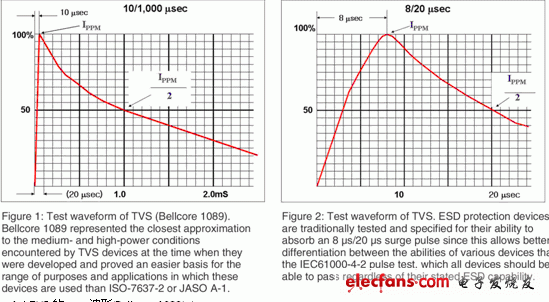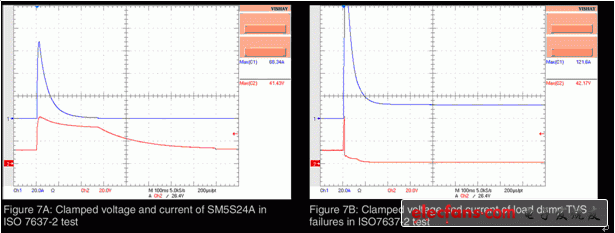In the design of the car, a major problem is the protection of electronic devices such as control units, sensors, infotainment systems, etc., from harmful surges, voltage transients, ESD and noise on the power line. Transient Voltage Suppressors (TVS) are ideal for protecting automotive electronics. Some parameters are important for these applications, including power level, off-state voltage, breakdown voltage, and maximum breakdown voltage. Below are the definitions of these parameters.
This article refers to the address: http://
Power level
The power level of a TVS is the ability to absorb surges under certain test or application conditions. The industry standard test conditions for a 10 μs/1000 μs pulse waveform (Bellcore 1089 standard) are shown in Figure 1. This test condition is different from the test condition of TVS transient voltage absorption capability. The absorption capability is tested with a pulse waveform of 8 μs/20 μs, as shown in Figure 2.

Figure 1: TVS test waveform (Bellcore 1089) Figure 2: TVS waveform
Breakdown voltage (VBR)
The breakdown voltage is the voltage at which the device enters the avalanche breakdown and is tested using the specific current conditions on the data sheet.
Maximum breakdown voltage (VC: clamp voltage)
At a certain peak pulse current level, a clamp voltage appears on the TVS. The breakdown voltage of the TVS is measured at very low current, such as 1 mA or 10 mA, which is different from the actual avalanche voltage under application conditions. Therefore, the typical or maximum breakdown voltage noted by the semiconductor manufacturer corresponds to a large current.
Off-state operating voltage (VWM): Off-state reverse voltage during operation
The off-state voltage refers to the highest voltage that the TVS can withstand without breakdown, and is an important parameter of the protection device that does not work under normal conditions in the circuit. In the car, some automotive electronics regulations are based on the “jump start protection†situation. In this case, a 12-second 23 VDC power supply is required for the 12 V electronic device, and the 24 VDC electronic device is powered by the 36 VDC power supply for 10 minutes without damaging the circuit or causing malfunction. Therefore, the off-state voltage is a key parameter of TVS used in automotive electronics.
Initial protection of the car's power cord (load dump)
Automotive electronics such as electronic control units, sensors, and infotainment systems are connected to the power line. The power supplies for these electronic products are batteries and generators, which have unstable output voltages and are susceptible to temperature, operating conditions and other conditions. In addition, automotive systems that use electromagnetic coil loads, such as fuel nozzles, valves, motors, electronics, and hybrid controllers, introduce ESD, spike noise, and other types of transient and surge voltages into the power and signal lines.
What is load shedding?
When the engine starts working, the battery is disconnected from the power line, and the generator continues to output current to the car's power line, which is the worst case of a surge voltage. This situation is called “load dumpingâ€. Most car manufacturers and industry associations will set the maximum voltage, line impedance, and duration of this load shedding state for this load shedding state, as shown in Figure 5. . The source impedance of the load rejection is higher than the impedance of the transient test under normal conditions. Since the battery has been disconnected, only the generator is outputting power outward, and the internal coil of the generator acts like a current limiting resistor.

During the load shedding process, a general consideration of the dynamic behavior of the generator is required:
a) Under load shedding, the internal resistance of the generator is primarily a function of the speed and excitation current of the generator.
The load resistance test can be calculated by the following relationship plus the internal resistance of the generator Ri
Ri = ( 10 X Unom X Nact ) / ( 0.8 X Irated X 12,000 min -1 ),
Here
Unom is the rated voltage of the generator;
Nact is the rated current of a generator with a speed of 6000 rpm (given in ISO 8854)
Irated is the actual generator speed in the few minutes of interaction.
Two well-known tests simulate this condition: ISO-7637-2 Pulse 5 in the US, JASO A-1 for 14V powertrain in Japan, and JASO D-1 for 27V powertrain. In this section, we will summarize the TVS applications for load shedding in the 14V powertrain.
Standards and results of load rejection tests
The simulation conditions for the 14V powertrain of the US ISO-7637-2 Pulse 5 and Japan's JASO A-1 are shown in the following table.

Some automakers have adopted different conditions for load shedding testing based on ISO-7637-2 Pulse 5. The peak clamp current of the load dump TVS can be estimated using the following equation.
Formula for calculating peak clamp current
IPP= (Vin– VC) ℠Ri
IPP: Peak Clamp Current
Vin: Input voltage
VC: Clamping voltage
Ri: Line Impedance Protection for Negative Voltage Transient and Reverse Supply Voltage #e#
The current and voltage waveforms of Vishay's SM5S24A are shown in Figure 7A for the 87V ISO-7637-2 test for 13.5V battery, 0.75Ω Ri and 400ms pulse width.

Figure 7A: Clamping voltage and current of SM5S24A in ISO 7637-2 test Figure 7B: Clamping voltage and current in the case of load-shedding TVS failure in ISO7637-2 test
In Figure 7B, at 87V ISO-7637-2 test for 13.5V battery, 0.5Ω Ri and 400ms pulse width, the clamp voltage and current of the load dump TVS are disabled because the device is dissipated too much. The clamp voltage drops to near 0V, and the current flowing through the device reaches the maximum allowable line impedance.
The maximum clamping capability of the Vishay load-shedding TVS is shown in Figure 7C under the test conditions of 13.5 V Vbatt and 400 ms pulse width as specified by ISO-7637-2 pulse 5. To prevent the failure condition in Figure 7B, the maximum level of TVS is taken very seriously.

Protection against negative voltage transients and reverse supply voltage
There are two types of load-shedding TVS for primary protection of automotive electronics: epitaxial and non-epitaxial. In reverse bias mode, the two product groups have similar operational breakdown characteristics. The difference is that the epitaxial TVS has a low forward voltage drop (VF) characteristic in the forward mode, and the non-epitaxial TVS has a relatively high VF under the same conditions. This feature is important for negative voltage sources connected to the power line. Most CMOS ICs and LSIs have very poor reverse voltage characteristics.
The gate of the MOSFET is also vulnerable at a reverse voltage of -1V or lower. In the reverse power input mode, the voltage of the power line TVS VF is the same. This reverse bias mode can cause malfunction of the electronic circuit. The low forward voltage drop of EPI PAR TVS is a good solution to this problem. Another way to protect the circuit from reverse power input is to place a polarity-protected rectifier in the power line, as shown in Figure 8. The polarity protection rectifier should have sufficient forward current rating, as well as forward surge and reverse voltage performance.
Secondary protection of the car's power cord
The primary goal of a protection circuit in an automotive system is a high surge voltage, but the voltage clamped is still high. Therefore, secondary protection is particularly important in 24V powertrains, such as powertrains in trucks and vans. The main reason is that the input voltage of most regulators and DC-DC converter ICs is 45V~60V. For such applications, it is recommended to use the secondary protection in Figure 9.
Adding a resistor R to the power line reduces the transient current so that a smaller power level TVS can be used for secondary protection. The current required by the microcontroller and logic in the electronics unit is 150mA~300mA. The minimum output voltage of the 12V battery at -18°C is 7.2V. Under the same conditions, the minimum output voltage of the 24V battery is 14.4V. In a 24V battery under the same conditions, the supply voltage is 8.4 V at a load of 300 mA and R = 20 Ω, which is 11.4 at R = 10 Ω and 14.4 V (minimum voltage of a 24 V battery at -18 ° C). V.

VL = (Vmin℠(Vmin℠IL)) × ((Vmin℠IL) – R)
VL: load voltage
Vmin: minimum input voltage
IL: load current
R: resistance value
R power level = I2R
For most voltage regulators and DC/DC converter ICs, the supply voltage is higher than the minimum input voltage to avoid erroneous operation of the circuit due to low voltage input.
Since safety and reliability in automotive systems are very important considerations, these are beyond the scope of this article.
Magnetic Lighting,Magnetic Under Cabinet Lighting,Modular Magnetic Lighting,Outdoor Magnetic Lighting
SHENZHEN KEHEI LIGHTING TECHNOLOGY CO.LTD , https://www.keheiled.com